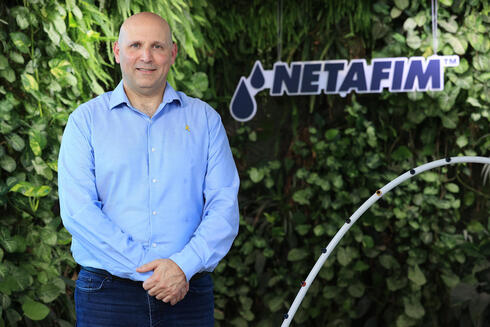
Orbia eyes sale of Netafim for $1.3–1.5 billion amid financial pressure
Mexican conglomerate hires Evercore, remaining bidders include European and Israeli funds.
Israeli irrigation pioneer Netafim is once again up for sale. Eight years after Mexico’s Mexichem, now known as Orbia, acquired 80% of the company from the Permira fund, the Mexican conglomerate has decided to put the Israeli firm back on the market.
According to information obtained by Calcalist, Orbia has hired investment bank Evercore to manage the sale process, and an information room has been opened for prospective investors. Several international investment funds have reviewed the materials, though some have since withdrawn. Currently, three funds remain in the running: two foreign, at least one of them European, and one Israeli, Fortissimo, which previously attempted to acquire John Deere’s water division (formerly Plastro Gvat) but lost out to FIMI, which later exited the investment for hundreds of millions of dollars.
The funds have met with Orbia and Netafim executives and are now conducting due diligence, with the goal of completing a deal in the coming quarter. Kibbutz Hatzerim, which holds 20% of Netafim, is not expected to participate in the sale this time either.
Orbia has struggled to improve Netafim’s performance since the 2018 acquisition. While the company was purchased for $1.8 billion, the current sale is expected to value it between $1.3 billion and $1.5 billion, a significant drop. Orbia originally paid $1.5 billion for its controlling stake, including $241 million to Kibbutz Hatzerim and Magal, and the remainder to Permira.
Permira itself acquired Netafim from the Tene fund in 2011 at a valuation of $850 million. Earlier, in 2006, Tene and Markstone bought 30% of Netafim for about $150 million.
The planned sale reflects Orbia’s financial distress. Its stock on the Mexican exchange has plunged nearly 60% over the past five years, falling from a $7 billion market cap at the time of the Netafim acquisition to around $1.7 billion today. The company is also burdened with $8.6 billion in debt, making repayment difficult with annual revenues of just $7.5 billion.
In recent financial statements, Orbia indicated plans to sell assets, without naming Netafim specifically.
Orbia’s core business lies in petrochemicals, manufacturing PVC pipes for municipal and domestic water infrastructure, construction, communications, and beverage industries. Founded in 1953, the company is now headquartered in Boston, having relocated from Mexico.
It also produces chemical products and operates 120 manufacturing plants in 41 countries, employing roughly 23,000 people (excluding Netafim). The group owns two mines and two innovation centers.
When Orbia bought Netafim, then-CEO Antonio Carrillo Rule led the deal; he was replaced in 2021 by Sameer Bharadwaj, an American executive. Netafim currently represents about 15% of Orbia’s business, but, like much of the agriculture technology sector, it has been hit by rising interest rates and a slowdown in sales.
Related articles:
A Global Irrigation Pioneer
Founded 60 years ago by Kibbutz Hatzerim, Netafim is regarded as one of Israel’s most important technological breakthroughs, often compared to Waze in its global influence. The company invented drip irrigation, a system that transforms powerful water flow into a controlled drip, revolutionizing modern agriculture.
Today, Netafim remains the world’s largest precision irrigation company, with annual revenues exceeding $1 billion, outpacing its closest competitor, Rivulis, which generates about $700 million. The company is led by Gaby Miodownik, who oversaw its integration with Orbia after the acquisition. It employs approximately 5,500 people and operates in 40 countries through 20 factories.
Despite Orbia’s ambitions, the acquisition failed to accelerate Netafim’s global expansion, and the broader industry downturn deepened the company’s challenges.
In Orbia’s financial reports, Netafim’s results are included under the “Precision Agriculture” division, which posted revenues of $1.038 billion in 2024, down 3% from $1.063 billion in 2023. Over the past three years, revenues and profitability have steadily declined. Operating profit dropped to $6 million in 2024, from $13 million in 2023 and $19 million in 2022. EBITDA has remained relatively stable at around $120–125 million annually.
The difficulties trace back to the COVID-19 pandemic and the subsequent spike in interest rates, which eroded farm investment and profitability. Farmers, Netafim’s main customers, tend to purchase seeds annually but replace irrigation systems only every 10–15 years. With financing costs rising and crop prices falling, many have delayed equipment upgrades, pressuring the entire precision irrigation sector.
Netafim has sought to diversify into crops like sugarcane and cocoa, but the war in Israel also disrupted its operations. The company’s plant in Kibbutz Yiftah, near the Lebanese border, continued working through much of the fighting.
Still, 2025 appears to mark the beginning of a recovery. As global interest rates start to ease, investors’ attention is returning to the sector. Netafim’s revenues in the first half of 2025 rose to $560 million, up from $540 million a year earlier, while operating profit climbed 20%, from $15 million to $18 million.
By contrast, Orbia’s overall performance continues to weaken: first-half 2025 revenues fell to $3.78 billion, from $3.84 billion a year earlier, and full-year 2024 sales dropped to $7.5 billion, down from $8.2 billion in 2023 and $9.6 billion in 2022. Net profit plunged from $567 million in 2022 to just $65 million in 2023, recovering slightly to $145 million in 2024, before the company reported a $180 million loss in the first half of 2025, compared to a profit of $148 million in the same period last year.
